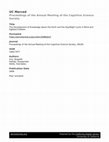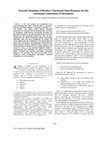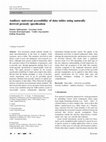Papers by Ikospentaki Kalliopi

The Development of Knowledge about the Earth and the Day/Night Cycle in Blind and Sighted Childre... more The Development of Knowledge about the Earth and the Day/Night Cycle in Blind and Sighted Children Ikospentaki Kalliopi (kikospe@phs.uoa.gr), Vosniadou Stella (svosniad@phs.uoa.gr) & Skopeliti Irini (eskopel@phs.uoa.gr) Department of Philosophy and History of Science, University of Athens Panepistimioupolis, GR.157 71 Athens – Greece grade mean score:14.9, 3 rd grade mean score:18.7), and for group [F(3,1)=,014 p<.01] in favor of the sighted children (blind children mean score:15.4; sighted children mean score:18.2). The analysis also showed that the blind children constructed fewer scientific models of the earth and the day/night cycle than the sighted children and also fewer and less developed alternative models. Introduction We present the results of a study that compared sighted and congenitally blind children’s knowledge of the earth and the day/night cycle. Our interest is focused on how congenitally blind children understand scientific information about the earth and the d...

This work presents an experimental study towards modeling the readerspsila emotional state as a r... more This work presents an experimental study towards modeling the readerspsila emotional state as a response to font and typesetting elements of documents presented on a LCD display. Any content and/or domain dependent information was excluded from the document that was tested. An automated computer-based experimental procedure has been followed based on the paper-and-pencil self assessment Manikin test. The typographic elements: font color, size, type, background color and the typesetting elements: bold, italics, bold-italics, along with their combinations are studied. The results indicate that the combination of text and background color has the same impact across languages; the font size has a typical behavior. Readerspsila emotional state, induced by the typesetting elements and the font type, probably depends on the current as well as on the previously displayed stimuli. A cognitive-based XML architecture for real-time extraction of readerspsila emotional state relatively to documentspsila typographic elements is also presented. The results of this paper can be considered when transforming emotionally annotated documents into acoustic modality.

Universal Access in The Information Society, 2010
Text documents usually embody visually oriented meta-information in the form of complex visual st... more Text documents usually embody visually oriented meta-information in the form of complex visual structures, such as tables. The semantics involved in such objects result in poor and ambiguous text-to-speech synthesis. Although most speech synthesis frameworks allow the consistent control of an abundance of parameters, such as prosodic cues, through appropriate markup, there is no actual prosodic specification to speech-enable visual elements. This paper presents a method for the acoustic specification modelling of simple and complex data tables, derived from the human paradigm. A series of psychoacoustic experiments were set up for providing speech properties obtained from prosodic analysis of natural spoken descriptions of data tables. Thirty blind and 30 sighted listeners selected the most prominent natural rendition. The derived prosodic phrase accent and pause break placement vectors were modelled using the ToBI semiotic system to successfully convey semantically important visual information through prosody control. The quality of the information provision of speech-synthesized tables when utilizing the proposed prosody specification was evaluated by first-time listeners. The results show a significant increase (from 14 to 20% depending on the table type) of the user subjective understanding (overall impression, listening effort and acceptance) of the table data semantic structure compared to the traditional linearized speech synthesis of tables. Furthermore, it is proven that successful prosody manipulation can be applied to data tables using generic specification sets for certain table types and browsing techniques, resulting in improved data comprehension.
Cognitive Development, 2004

Learning and Instruction, 2005
This experiment investigated the effect of the presentation of a globe e the culturally accepted ... more This experiment investigated the effect of the presentation of a globe e the culturally accepted artifact representing the earth e on children's reasoning in elementary astronomy. Forty-four children from grades 1 and 3 were interviewed individually. First, the children were asked to make their own representations of the earth (i.e., drawings and play-dough models) and to indicate where people live on the earth. Then, the same children were presented with the globe and were asked to answer another set of questions regarding the shape of the earth and the areas where people live. The results showed an increase in the frequency of correct responses with the presentation of the globe, but also a decrease in the overall consistency of responses. Only some (the older) children could profit from the presence of the artifact to construct an internally consistent scientific model of the earth. Many children employed a mixed way of responding, sometimes basing their answers on the externally provided model and sometimes on their prior knowledge. These latter children did not seem to be aware of what they were doing. It appears that in the absence of an external, cultural model, children can form internal representations which they can distort in ways that make them consistent with their prior knowledge. But, when the cultural artifact is Learning and Instruction 15 (2005) 333e351 www.elsevier.com/locate/learninstruc present, such distortions are not possible with the result that children end up with internally inconsistent patterns of responses.







Uploads
Papers by Ikospentaki Kalliopi